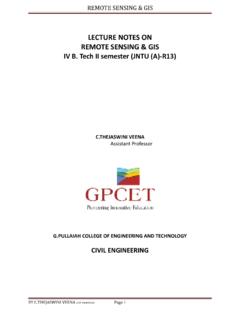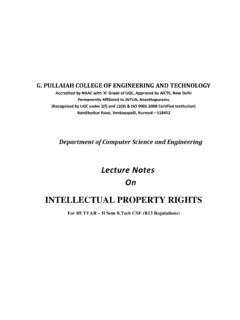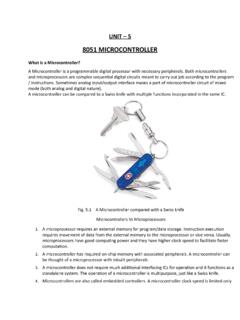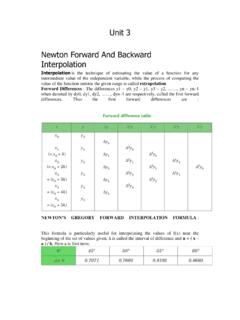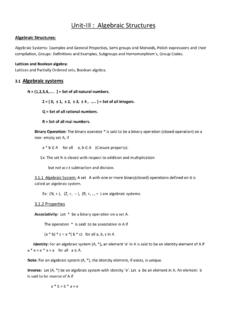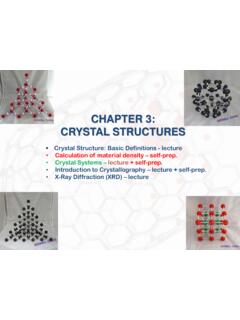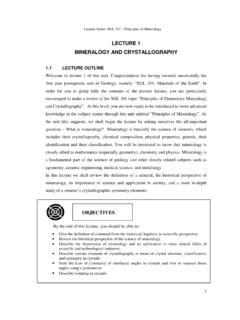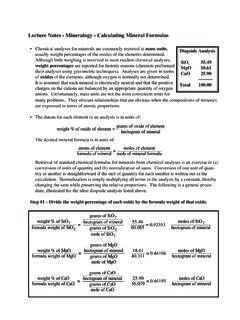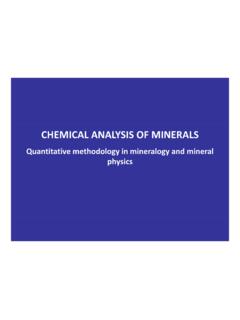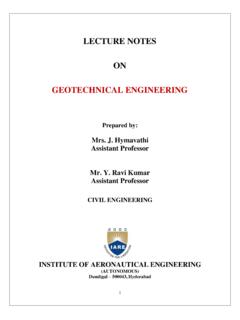Transcription of SHEAR STRENGTH OF SOIL - G. Pullaiah College of ...
1 SHEAR STRENGTH OF soil Necessity of studying SHEAR STRENGTH of soils : soil failure usually occurs in the form of shearing along internal surface within the soil . SHEAR STRENGTH : Thus, structural STRENGTH is primarily a function of SHEAR STRENGTH . The STRENGTH of a material is the greatest stress it can sustain The safety of any geotechnical structure is dependent on the STRENGTH of the soil If the soil fails, the structure founded on it can collapse Thus SHEAR STRENGTH is The capacity of a material to resist the internal and external forces which slide past each other Significance of SHEAR STRENGTH : - Engineers must understand the nature of shearing resistance in order to analyze soil stability problems such as.
2 - Bearing capacity - Slope stability - Lateral earth pressure on earth-retaining structure SHEAR Failure under Foundation Load Slope Stability Failure as an Example of Shearing Along Internal Surface At failure, SHEAR stress along the failure surface reaches the SHEAR Thus SHEAR STRENGTH of soil is The capacity of a soil to resist the internal and external forces which slide past each other SHEAR STRENGTH in Soils : - The SHEAR STRENGTH of a soil is its resistance to shearing stresses. - It is a measure of the soil resistance to deformation by continuous displacement of its individual soil particles. - SHEAR STRENGTH in soils depends primarily on interactions between particles.
3 - SHEAR failure occurs when the stresses between the particles are such that they slide or roll past each other Components of SHEAR STRENGTH of soils soil derives its SHEAR STRENGTH from two sources: Cohesion between particles (stress independent component) Cementation between sand grains Electrostatic attraction between clay particles Frictional resistance and interlocking between particles (stress dependent component) Cohesion : Cohesion (C), is a measure of the forces that cement particles of soils Internal Friction : Internal Friction angle (f), is the measure of the SHEAR STRENGTH of soils due to friction Angle of Repose Angle of Repose determined by: Particle size (higher for large particles) Particle shape (higher for angular shapes) SHEAR STRENGTH (higher for higher SHEAR STRENGTH ) Stresses: Gravity generates stresses (force per unit area) in the ground at different points.
4 Stress on a plane at a given point is viewed in terms of two components: Normal stress ( ) : acts normal to the plane and tends to compress soil grains towards each other (volume change) SHEAR stress ( ): acts tangential to the plane and tends to slide grains relative to each other (distortion and ultimately sliding failure). lecture 31 Factors Influencing SHEAR STRENGTH : The shearing STRENGTH , is affected by: soil composition: mineralogy , grain size and grain size distribution, shape of particles, pore fluid type and content, ions on grain and in pore fluid. Initial state: State can be describe by terms such as: loose, dense, overconsolidated, normally consolidated, stiff, soft, etc. Structure: Refers to the arrangement of particles within the soil mass; the manner in which the particles are packed or distributed.
5 Features such as layers, voids, pockets, cementation, etc, are part of the structure. Mohr-Coulomb Failure Criteria: This theory states that a material fails because of a critical combination of normal stress and SHEAR stress, and not from their either maximum normal or SHEAR stress alone. Direct SHEAR Test: Dry sand can be conveniently tested by direct SHEAR tests. The sand is placed in a SHEAR box that is split into two halves . A normal load is first applied to the specimen. Then a SHEAR force is applied to the top half of the SHEAR box to cause failure in the sand. The normal and SHEAR stresses at failure are lecture 33 Triaxial Tests Triaxial compression tests can be conducted on sands and clays shows a schematic diagram of the Triaxial test arrangement.
6 Essentially, it consists of placing a soil specimen confined by a rubber membrane in a Lucite chamber. An all-round confining pressure ( 3) is applied to the specimen by means of the chamber fluid (generally water or glycerin). An added stress ( ) can also be applied to the specimen in the axial direction to cause failure ( = f at failure). Drainage from the specimen can be allowed or stopped, depending on the test condition. For clays, three main types of tests can be conducted with Triaxial equipment: Triaxial test: 1. Consolidated-drained test (CD test) 2. Consolidated-undrianed test (CU test) 3. Unconsolidated-undrained test (UU test) Major Principal effective stress = 3= f= 1= 1 Minor Principal effective stress = 3= 3 Changing 3 allows several tests of this type to be conducted on various clay specimens.
7 The SHEAR STRENGTH parameters (c and ) can now be determined by plotting Mohr s circle at failure, as shown in figure and drawing a common tangent to the Mohr s circles. This is the Mohr-Coulomb failure envelope. (Note: For normally consolidated clay, c 0). At failure For consolidated-undrained tests, at failure, Major Principal total stress = 3= f= 1 Minor principal total stress = 3 Major principal effective stress =( 3+ f) uf= 1 Minor principal effective stress = 3 uf= 3 Changing 3 permits multiple tests of this type to be conducted on several soil specimens. The total stress Mohr s circles at failure can now be plotted, as shown in figure , and then a common tangent can be drawn to define the failure envelope.
8 This total stress failure envelope is defined by the equation s=ccu+ tan cu Where ccu and cu are the consolidated-undrained cohesion and angle of friction respectively (Note: ccu 0 for normally consolidated clays) Similarly, effective stress Mohr s circles at failure can be drawn to determine the effective stress failure envelopes. They follow the relation expressed in equation . For unconsolidated-undrained triaxial tests Major principal total stress= 3= f= 1 Minor principal total stress = 3 The total stress Mohr s circle at failure can now be drawn, as shown in figure. For saturated clays, the value of 1 3= f is a constant, irrespective of the chamber confining pressure, tangent to these Mohr s circles will be a horizontal line, called the =0 condition.
9 The SHEAR stress for this condition is Where B=Skempton s pore pressure parameter Similarly,the pore pressure ud is the result of added axial stress, , so ud=A Where A=Skempton s pore pressure parameter However, = 1 3 Combining equations gives u=ua+ud=B 3+A 1 3 The pore water pressure parameter B in soft saturated soils is 1, so u= 3+A( 1 3) The value of the pore water pressure parameter A at failure will vary with the type of soil . Following is a general range of the values of A at failure for various types of clayey soil encountered in nature. UNCONFINED COMPRESSION TEST The unconfined compression test is a special type of unconsolidated-undrained Triaxial test in which the confining pressure 3=0, as shown in figure.
10 In this test an axial stress, , is applied to the specimen to cause failure (that is, = f). The corresponding Mohr s circle is shown in figure . Note that, for this case, u Unconfined compression test: (a) soil specimen; (b) Mohr s circle for the test; (c) variation of qu with the degree of saturation Major principal total stress = f=qu Minor principal total stress = 0 The axial stress at failure, f=qu is generally referred to as the unconfined compression STRENGTH . The SHEAR STRENGTH of saturated clays under this condition ( =0, The unconfined compression STRENGTH can be used as an indicator for the consistency of clays.)
